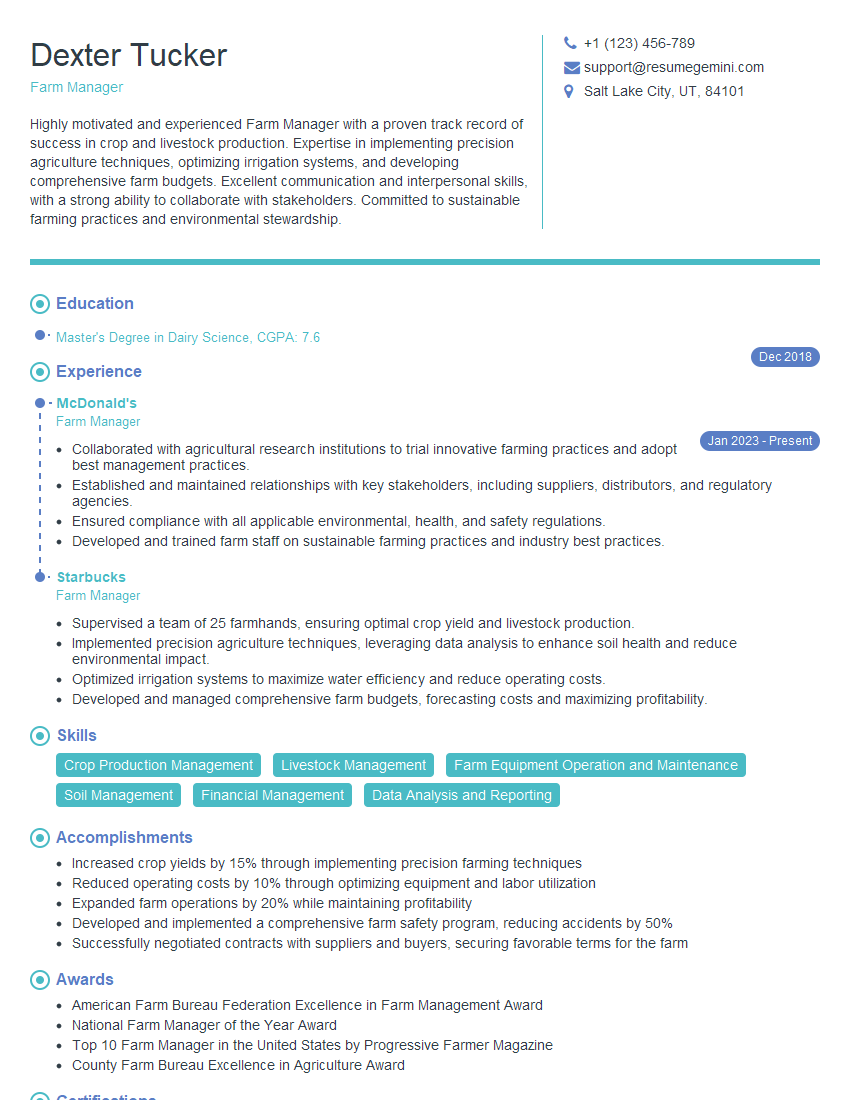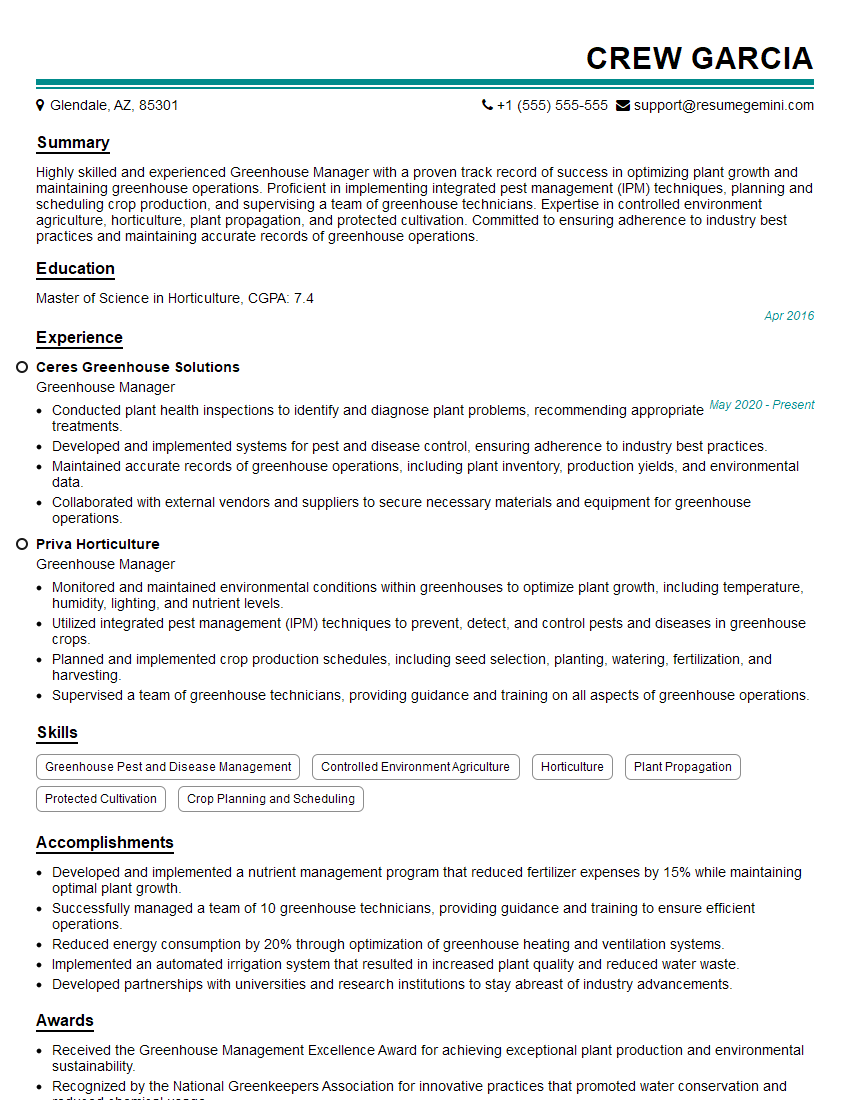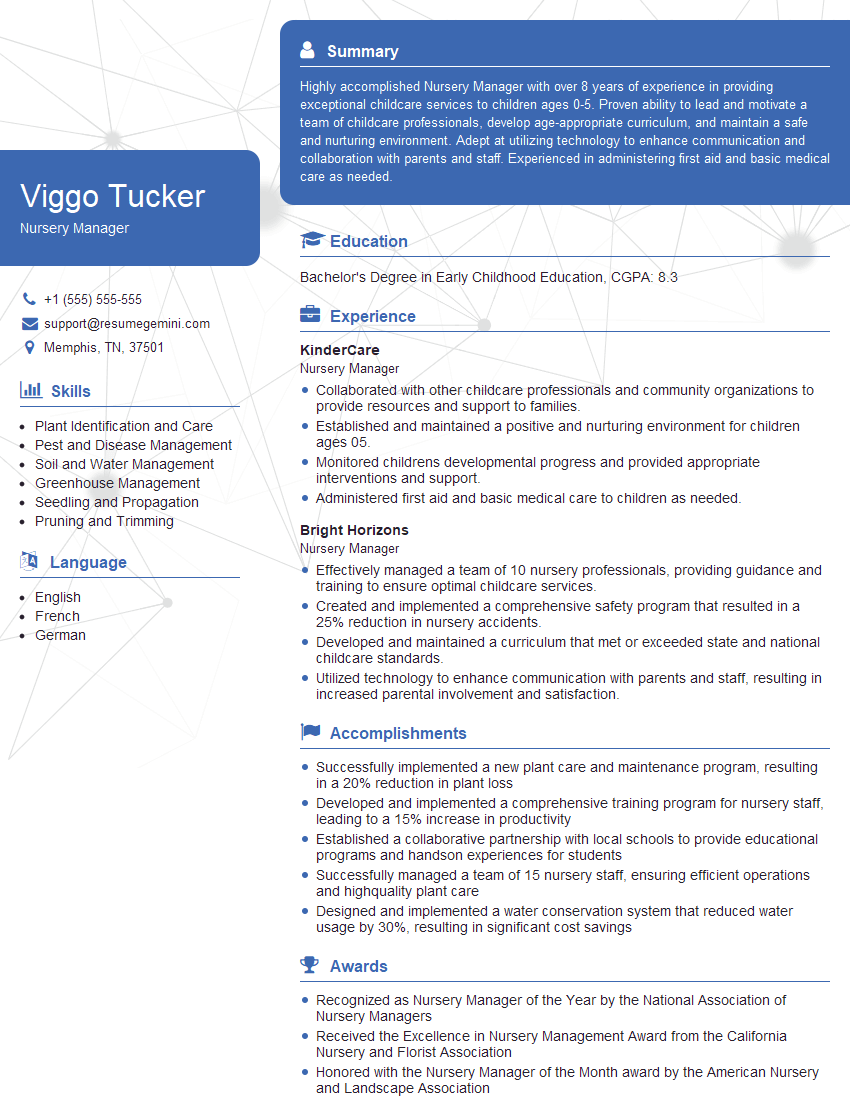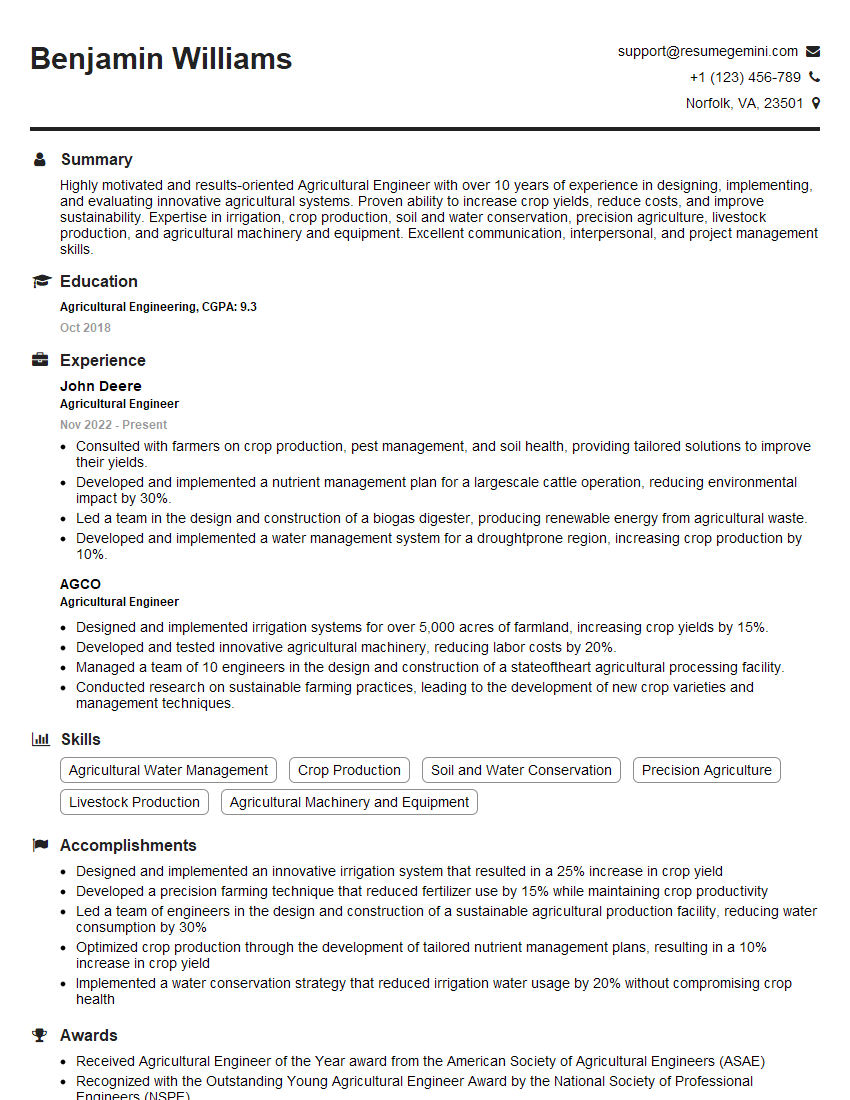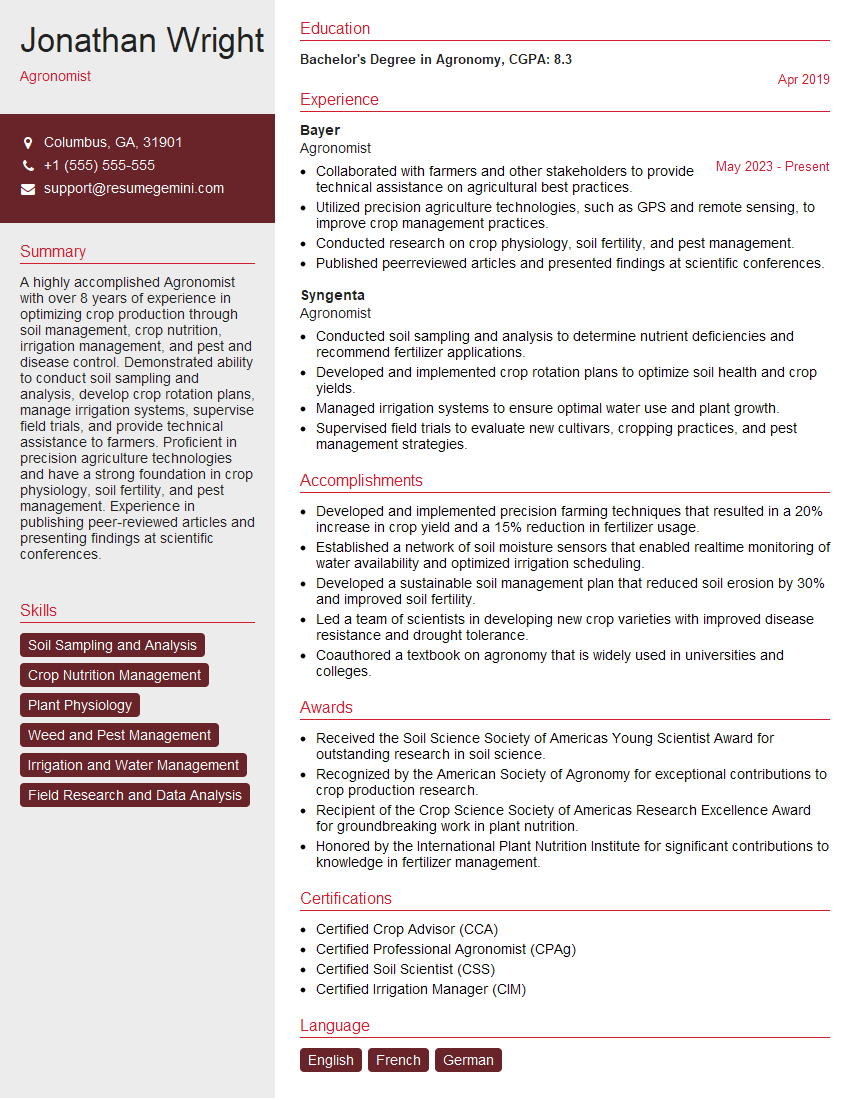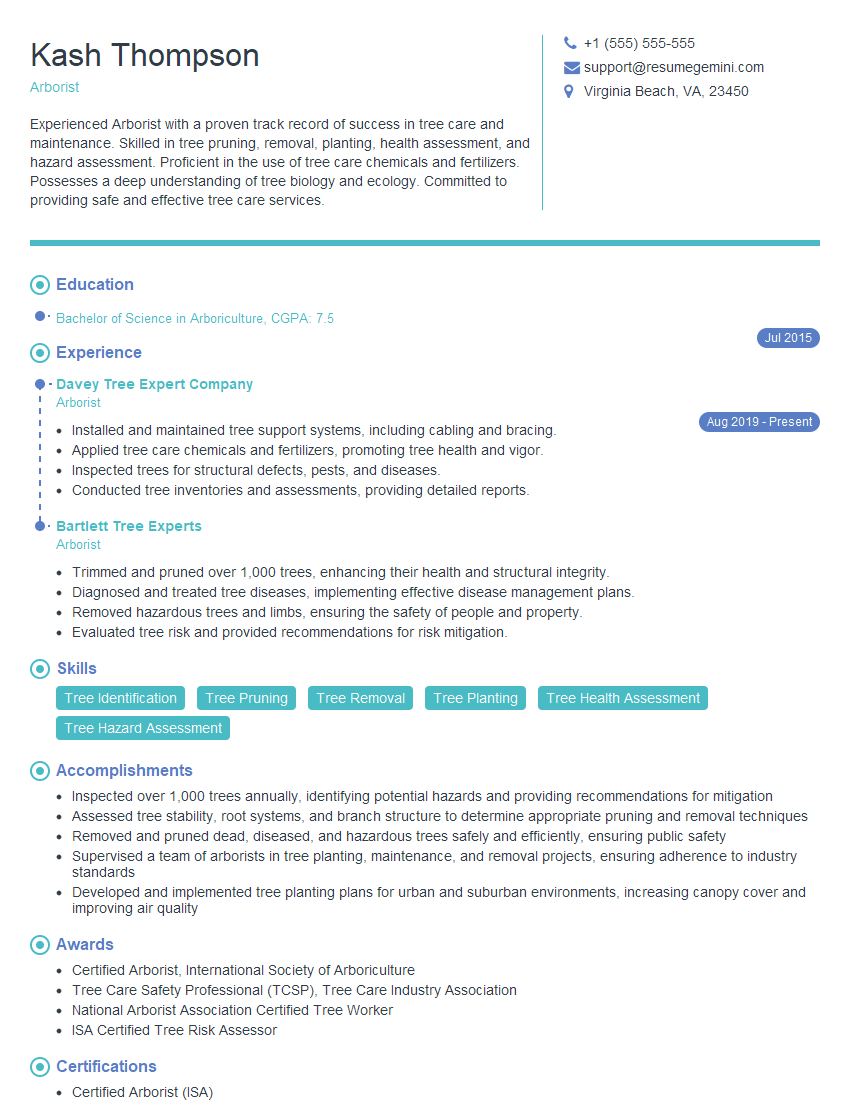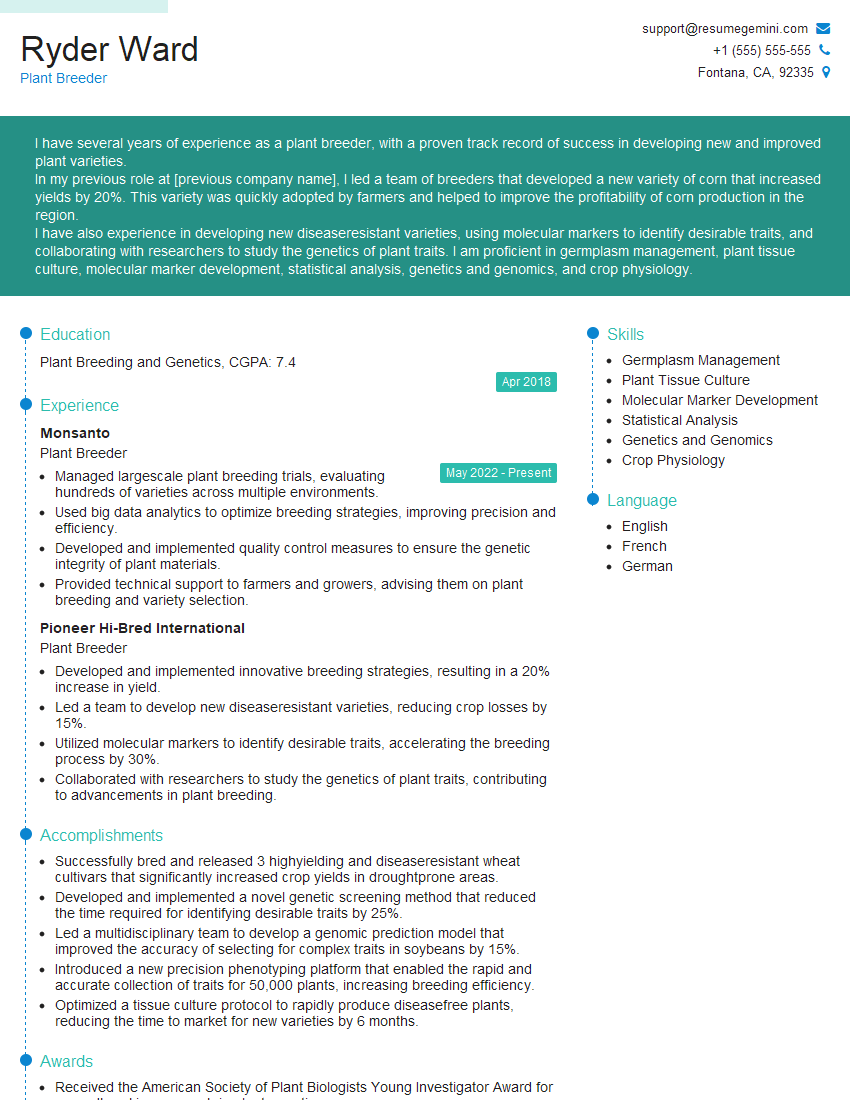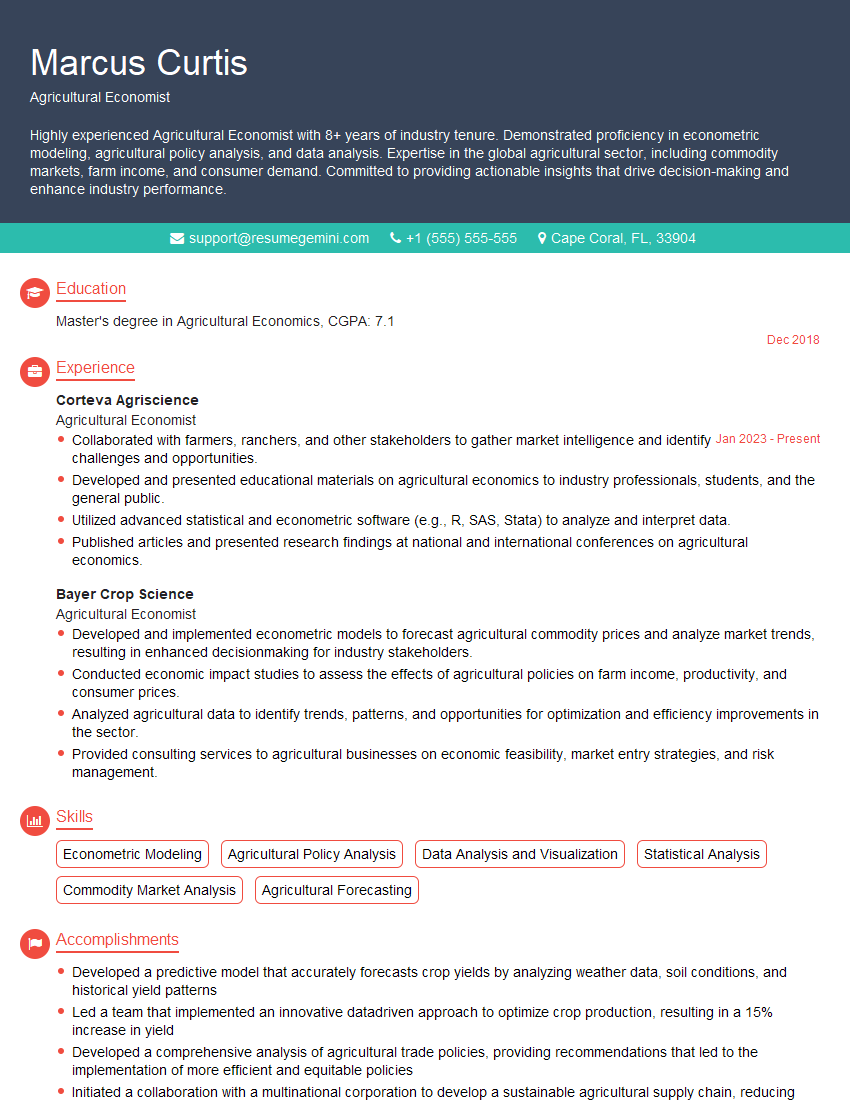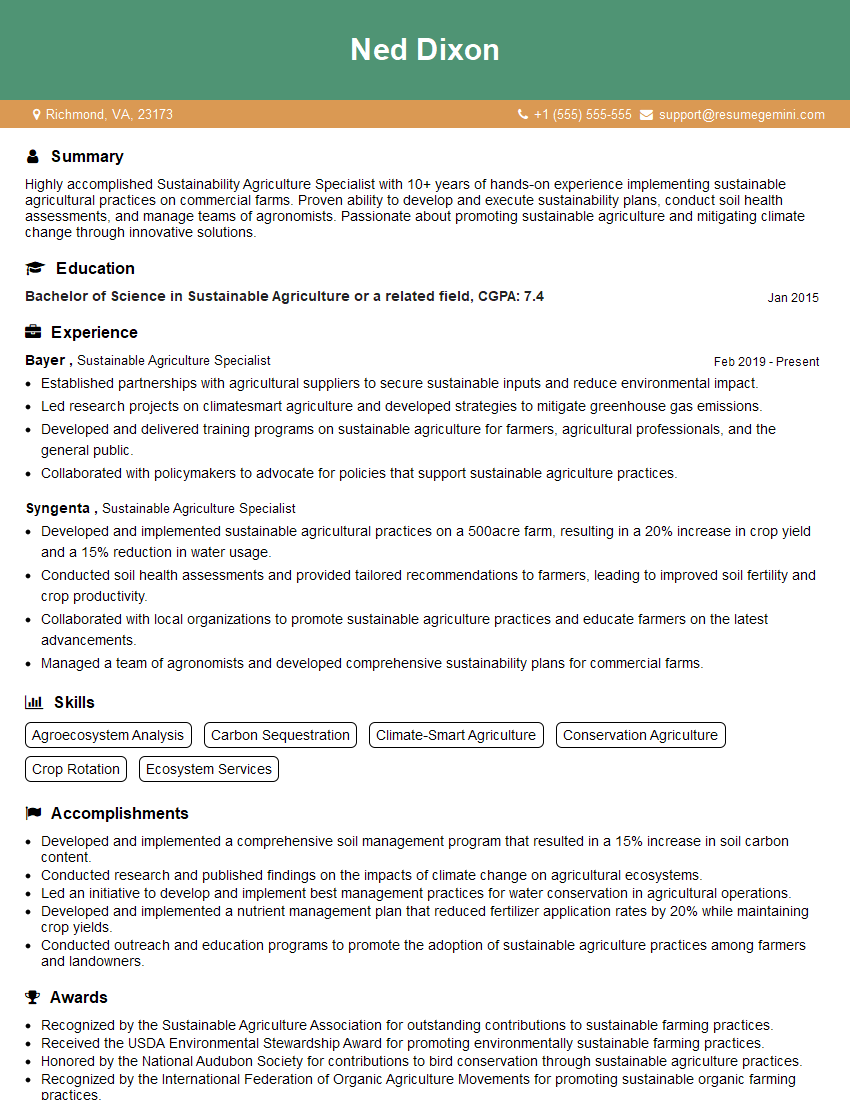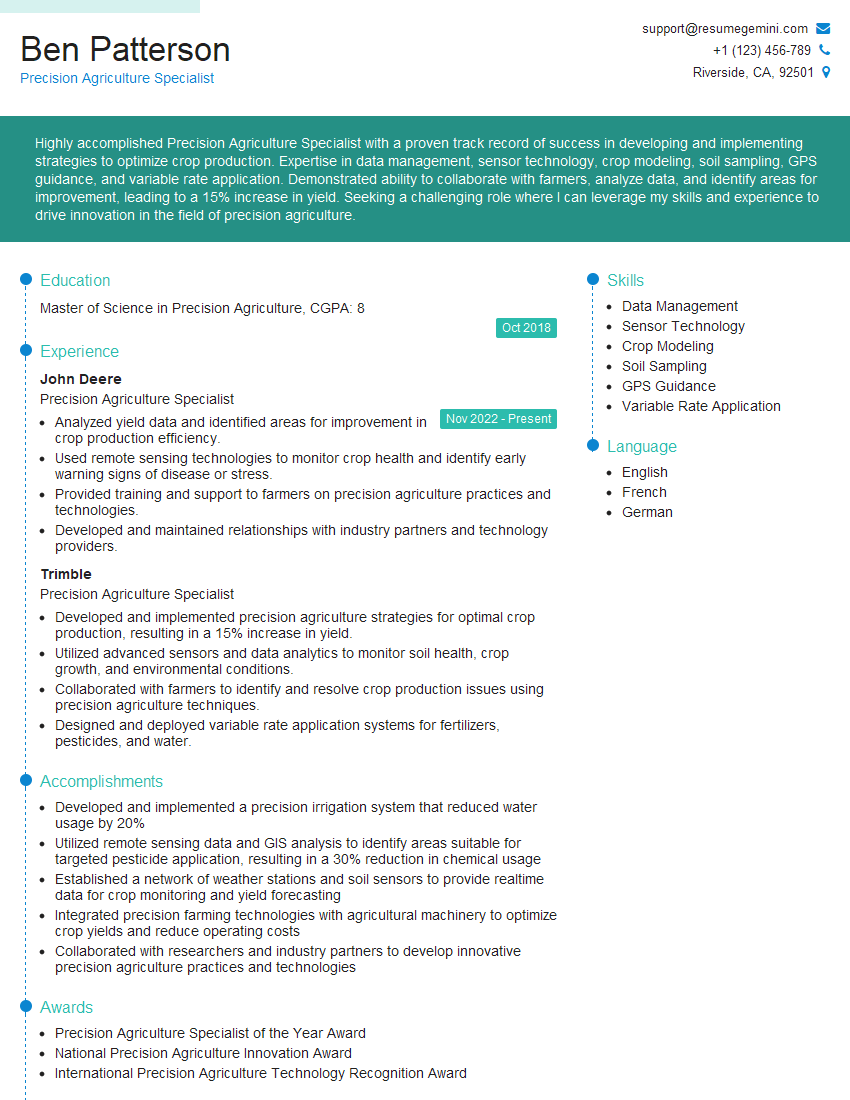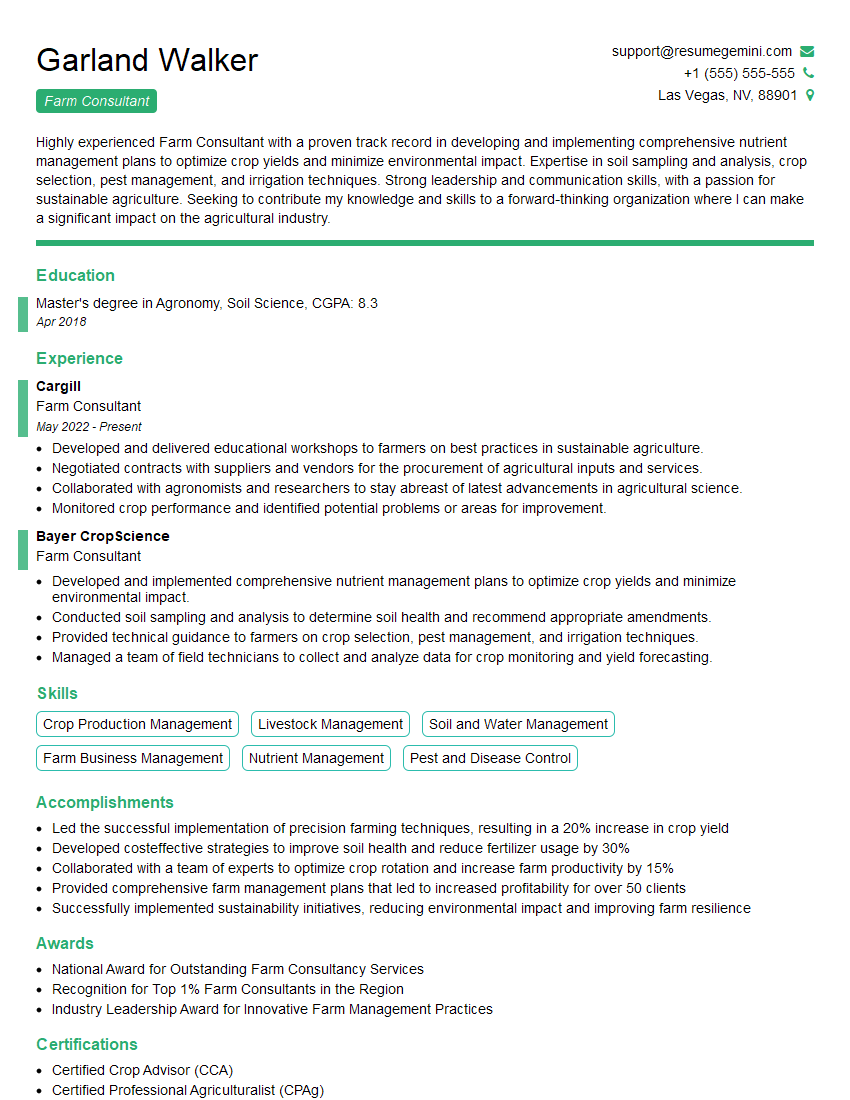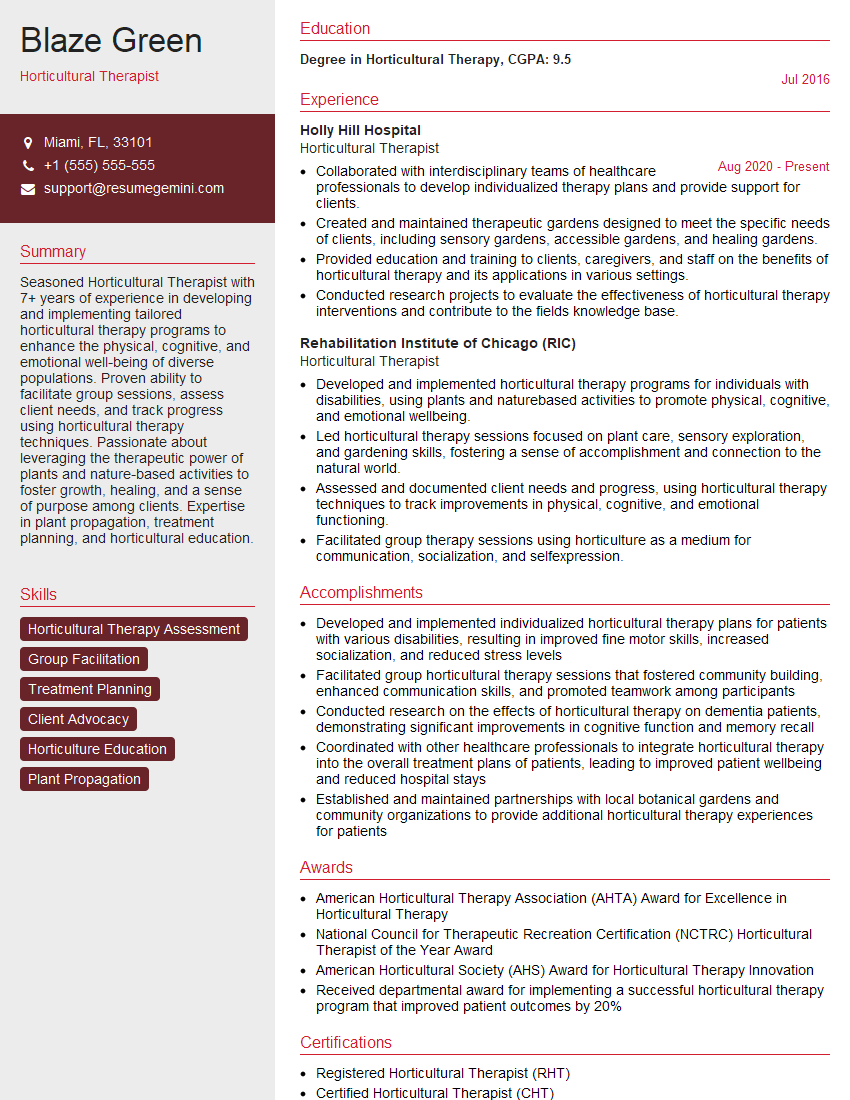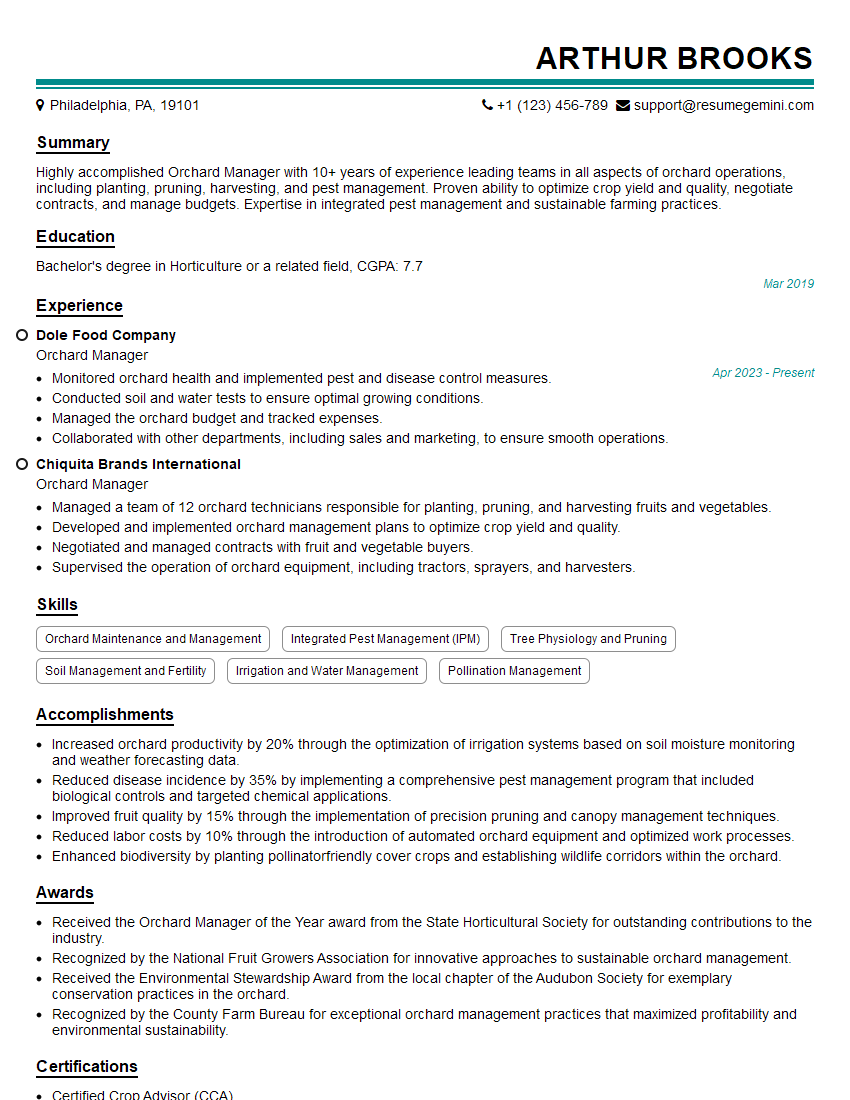The thought of an interview can be nerve-wracking, but the right preparation can make all the difference. Explore this comprehensive guide to Horticulture and Agronomy Practices interview questions and gain the confidence you need to showcase your abilities and secure the role.
Questions Asked in Horticulture and Agronomy Practices Interview
Q 1. Describe the different types of soil and their suitability for various crops.
Soil is broadly classified into three main types based on its texture: sandy, silty, and clayey. The proportions of sand, silt, and clay particles determine the soil’s structure, drainage, water-holding capacity, and nutrient availability, all of which significantly impact crop suitability.
- Sandy soils: These soils have large particles, resulting in excellent drainage but poor water retention. They are typically low in nutrients and are suitable for crops with low water requirements and drought tolerance, such as certain vegetables (e.g., carrots, radishes) and some grains (e.g., certain varieties of wheat).
- Silty soils: Silty soils are a balance between sand and clay, offering moderate drainage and water retention. They generally hold more nutrients than sandy soils and are suitable for a wide range of crops, including many fruits and vegetables.
- Clayey soils: These soils have tiny particles, leading to poor drainage and excellent water retention. They can be rich in nutrients but can become compacted, hindering root growth. Clayey soils are suitable for crops that tolerate wet conditions, such as rice, but require proper soil management techniques to improve aeration.
Beyond texture, soil pH (acidity or alkalinity) is another crucial factor. Different crops have different pH preferences. For instance, blueberries thrive in acidic soil (pH 4.5-5.5), while alfalfa prefers a neutral to slightly alkaline pH (6.5-7.5). Understanding soil type and pH is crucial for successful crop production; soil testing is a critical first step in determining appropriate crop choices and amending the soil to meet the crop’s needs.
Q 2. Explain the principles of plant propagation through cuttings and grafting.
Plant propagation through cuttings and grafting are asexual methods, meaning they produce new plants genetically identical to the parent plant. This is advantageous for maintaining desirable traits.
- Cuttings: This involves taking a stem, leaf, or root section from a parent plant and inducing it to root and grow into a new plant. The success rate depends on factors like the type of cutting (e.g., hardwood, softwood), the hormone application (e.g., rooting powder), and environmental conditions (humidity, temperature). For example, many shrubs like rose bushes are easily propagated using stem cuttings.
- Grafting: This involves joining a section of a plant (scion) onto another plant (rootstock). The scion provides the desired fruit or flower characteristics, while the rootstock provides disease resistance or desirable root system traits. Successful grafting requires careful alignment of the cambium layers (the actively growing tissue) and maintaining appropriate environmental conditions. This is commonly used in fruit tree production, for example, grafting a high-yield apple variety onto a rootstock that is resistant to certain soil-borne diseases.
Both methods require sterile techniques to prevent disease and ensure success. Proper selection of planting material and optimal environmental control are also essential for efficient propagation.
Q 3. What are the common methods for irrigation and their advantages and disadvantages?
Irrigation methods broadly categorize into surface irrigation (flood, furrow, border), sprinkler irrigation, and drip irrigation. Each has unique advantages and disadvantages:
- Surface Irrigation: This involves applying water directly to the soil surface.
- Flood irrigation: Simple but inefficient, high water loss through evaporation and runoff.
- Furrow irrigation: Water flows in channels between crop rows; less water loss than flooding but still susceptible to runoff.
- Border irrigation: Water flows across a level area; efficient for level fields.
- Sprinkler Irrigation: Water is sprayed over the field, mimicking rainfall.
- Advantage: More even water distribution than surface methods.
- Disadvantage: High water loss through evaporation and wind drift, higher energy consumption.
- Drip Irrigation: Water is delivered directly to the plant roots through a network of tubes and emitters.
- Advantage: Highest water use efficiency, minimal water loss, fertilizer can be applied directly.
- Disadvantage: High initial investment cost, potential for clogging, requires careful management.
The best method depends on factors such as topography, soil type, water availability, crop type, and cost.
Q 4. Discuss integrated pest management strategies for controlling common horticultural pests.
Integrated Pest Management (IPM) aims to control pests economically and sustainably, minimizing environmental impact. It involves a combination of strategies:
- Monitoring: Regular scouting to identify pests and their levels. Early detection is critical for effective control.
- Cultural Practices: Modifying growing conditions to discourage pests, such as crop rotation, selecting pest-resistant varieties, and proper sanitation.
- Biological Control: Introducing natural enemies of pests, such as predatory insects or beneficial nematodes.
- Chemical Control: Using pesticides only when necessary and at the lowest effective dose. This often involves targeting specific pest life stages.
For example, managing aphids on roses might involve monitoring their populations, removing infested leaves, introducing ladybugs (a natural predator), and using insecticidal soap only as a last resort if populations reach damaging levels. IPM emphasizes prevention and minimizing reliance on chemical pesticides.
Q 5. How do you diagnose plant nutrient deficiencies and correct them?
Diagnosing plant nutrient deficiencies involves observing visual symptoms and conducting soil and tissue tests. Visual symptoms can be very specific:
- Nitrogen (N) deficiency: Stunted growth, yellowing of older leaves.
- Phosphorus (P) deficiency: Dark green to purplish leaves, stunted growth.
- Potassium (K) deficiency: Leaf margins yellow and brown, leaf curling.
Soil tests reveal the overall nutrient content in the soil, while tissue tests analyze nutrient levels within the plant. Once a deficiency is identified, it’s corrected through fertilization. The type and amount of fertilizer applied will depend on the specific deficiency and soil test results. For example, if a soil test reveals low potassium, a potassium-rich fertilizer, such as potassium sulfate, is applied according to the recommended rates.
Q 6. Explain the role of soil microorganisms in plant health.
Soil microorganisms play a vital role in plant health, acting as the unseen workforce in the soil ecosystem. They influence nutrient cycling, disease suppression, and overall soil structure.
- Nutrient Cycling: Microbes decompose organic matter, releasing essential nutrients like nitrogen, phosphorus, and potassium in forms plants can easily absorb. Examples include nitrogen-fixing bacteria that convert atmospheric nitrogen into plant-usable forms.
- Disease Suppression: Some beneficial microbes compete with or directly inhibit plant pathogens, reducing disease incidence. This is a natural form of biological control.
- Soil Structure: Fungi and other microbes produce substances that bind soil particles, creating a more stable and well-aerated soil structure, beneficial for root growth and water infiltration.
Maintaining a healthy soil microbial community is crucial for sustainable agriculture. Practices like avoiding excessive tillage, adding organic matter, and using cover crops promote microbial diversity and activity.
Q 7. What are the key factors influencing crop yield?
Crop yield is a complex trait influenced by a multitude of factors, which can be broadly categorized into genetic, environmental, and management factors.
- Genetic factors: The inherent potential of the crop variety to produce a high yield. Choosing high-yielding varieties adapted to the specific environment is crucial.
- Environmental factors: These include climate (temperature, rainfall, sunlight), soil conditions (fertility, drainage, pH), and pest and disease pressure. Optimum environmental conditions are vital for maximum yield.
- Management factors: These encompass farming practices like planting density, irrigation, fertilization, pest and weed control, and harvesting techniques. Efficient management practices maximize resource use and yield.
For example, a high-yielding corn variety planted at the optimal density, with adequate irrigation and fertilization, and protected from pests and diseases, will likely produce a significantly higher yield than the same variety grown under suboptimal conditions.
Q 8. Describe different types of fertilizers and their application methods.
Fertilizers are crucial for providing plants with essential nutrients for healthy growth. They are broadly classified into organic and inorganic types. Organic fertilizers, like compost and manure, release nutrients slowly and improve soil structure. Inorganic fertilizers, also known as synthetic fertilizers, are manufactured and provide a readily available source of specific nutrients. Examples include Nitrogen (N), Phosphorus (P), and Potassium (K), often represented as NPK ratios (e.g., 10-10-10).
Application methods vary greatly depending on the fertilizer type and crop. Broadcasting involves spreading fertilizer evenly over the soil surface, suitable for granular fertilizers. Banding applies fertilizer in concentrated strips near the seeds or plants. This method is efficient and minimizes nutrient loss. Side-dressing involves placing fertilizer alongside the growing crop rows, useful for nitrogen supplementation during the growing season. Foliar application sprays nutrient solutions directly onto plant leaves, providing a rapid nutrient uptake but requiring careful application to avoid damage. Fertigation involves incorporating fertilizers into irrigation water for precise nutrient delivery. The best method depends on factors like soil type, crop requirements, and environmental conditions. For example, broadcasting is common for establishing pasture, while fertigation is ideal for hydroponic systems.
Q 9. Discuss the importance of soil testing and its interpretation.
Soil testing is fundamental to precision agriculture. It involves analyzing a soil sample to determine its nutrient content, pH level, texture, and other critical properties. This information guides fertilizer recommendations, ensuring efficient nutrient use and maximizing crop yields while minimizing environmental impact. Interpreting the results requires understanding the specific needs of the crop being grown and the soil’s inherent characteristics. For example, a soil test revealing low phosphorus levels indicates the need to supplement with phosphorus-rich fertilizers. Similarly, a low pH (acidic soil) may necessitate liming to improve soil conditions. Soil testing also helps identify potential problems like salinity or heavy metal contamination, allowing for timely corrective actions. Ignoring soil test results can lead to inefficient fertilizer use, reduced crop yields, and potential environmental damage.
Q 10. How do you manage weed pressure in different cropping systems?
Weed management is critical for maximizing crop yields and ensuring quality. Strategies vary widely depending on the cropping system. Preventive measures like crop rotation, cover cropping, and using weed-free seeds are crucial first steps. Cultural controls include proper tillage, timely planting, and competitive planting densities to suppress weed growth. Mechanical controls involve using tools like hoes, cultivators, and mowers to remove weeds physically. Biological controls utilize natural enemies of weeds, such as specific insects or pathogens, to control their populations. Chemical controls involve the use of herbicides, a powerful tool requiring careful selection and application to avoid harming crops or the environment. Integrated weed management (IWM) is a holistic approach combining multiple techniques tailored to specific situations. For instance, in organic farming, the emphasis is on cultural and biological controls, while conventional farming often integrates chemical controls with other methods. Careful monitoring and adapting strategies based on weed pressure are key for successful weed management.
Q 11. Explain the principles of crop rotation and its benefits.
Crop rotation is the practice of planting different crops in a planned sequence on the same field over multiple years. This practice offers several significant benefits. It breaks pest and disease cycles, reducing the reliance on pesticides and improving crop health. It improves soil structure and fertility by using different crops with varying nutrient needs. Legumes, for example, fix atmospheric nitrogen, enriching the soil for subsequent crops. It enhances weed management by disrupting weed life cycles and creating competition. Crop rotation can also improve water use efficiency and reduce erosion. For example, rotating corn (heavy feeder of nitrogen) with soybeans (nitrogen-fixing legume) provides a sustainable system. A well-planned crop rotation requires knowledge of crop needs, pest cycles, and soil characteristics. This careful planning delivers numerous environmental and economic advantages, promoting a healthier and more sustainable farming system.
Q 12. What are the different methods for harvesting and post-harvest handling of crops?
Harvesting and post-harvest handling methods are crucial for preserving crop quality and minimizing losses. Harvesting techniques vary greatly depending on the crop. Manual harvesting involves hand-picking, suitable for delicate fruits or vegetables. Mechanical harvesting uses machines like combines and harvesters, efficient for large-scale operations. Post-harvest handling includes cleaning, sorting, grading, and packaging. Proper storage conditions are critical, considering factors like temperature, humidity, and ventilation to maintain product quality and extend shelf life. For example, fruits and vegetables are often stored in controlled atmosphere storage to slow down respiration and prevent spoilage. Processing techniques, such as canning, freezing, or drying, further extend the shelf life and create value-added products. Efficient harvesting and post-harvest handling are essential for minimizing waste, ensuring product quality, and maximizing economic returns.
Q 13. Describe the impact of climate change on agricultural practices.
Climate change significantly impacts agricultural practices. Rising temperatures lead to altered growing seasons, increased heat stress on crops, and changes in water availability. Increased frequency and intensity of extreme weather events like droughts, floods, and storms cause crop damage and yield losses. Changes in precipitation patterns affect irrigation needs and increase the risk of water scarcity. The spread of pests and diseases is also influenced by climate change, demanding adaptation in pest management strategies. Rising CO2 levels can affect plant growth, but the overall effects are complex and vary across different crops and regions. Farmers need to adapt by adopting climate-smart agriculture practices, such as drought-resistant crop varieties, efficient irrigation techniques, and improved water management strategies. Climate change adaptation is crucial for ensuring food security and mitigating the impact on agricultural systems.
Q 14. How do you implement sustainable agricultural practices?
Sustainable agricultural practices aim to produce food and fiber while minimizing environmental impact and ensuring long-term resource availability. Key elements include: Crop diversification, using a variety of crops to reduce reliance on single crops and enhance resilience. Integrated pest management, using a combination of methods to control pests and reduce pesticide use. Conservation tillage, minimizing soil disturbance to reduce erosion and improve soil health. Water conservation, implementing efficient irrigation methods and rainwater harvesting techniques. Nutrient management, optimizing fertilizer use based on soil tests and crop needs to reduce nutrient runoff. Agroforestry, integrating trees into agricultural systems to provide multiple benefits. Organic farming, avoiding synthetic pesticides and fertilizers. Implementing sustainable practices requires a holistic approach and careful consideration of the specific environmental and economic context. Sustainable agriculture offers a pathway to food security and environmental stewardship, creating a more resilient and environmentally friendly food production system.
Q 15. Explain the principles of precision agriculture and its applications.
Precision agriculture is a farming management system that uses information technology to optimize the use of resources such as water, fertilizer, pesticides, and seeds. It involves collecting data on various aspects of the farm, analyzing that data, and then using the insights to make informed decisions about farm management. Think of it as giving your farm a detailed health check-up and tailoring its needs individually.
- Data Acquisition: This involves using sensors, drones, GPS, and remote sensing technologies to collect data on soil conditions, crop health, and weather patterns.
- Data Analysis: This stage involves using software and algorithms to analyze the collected data and identify areas that need attention, such as nutrient deficiencies or pest infestations.
- Variable Rate Technology (VRT): This is the application of the insights obtained through data analysis. For instance, VRT allows for the precise application of fertilizers or pesticides based on the specific needs of different parts of the field. Instead of blanket application, resources are targeted where needed, reducing waste and improving efficiency.
Applications: Precision agriculture finds its application in various areas like optimizing irrigation schedules through soil moisture sensors, applying the right amount of fertilizer to each section of a field, precise weed control using targeted herbicide application, and precise planting through automated guidance systems. For example, a vineyard might use sensors to monitor the water stress of each vine individually, ensuring optimal fruit production.
Career Expert Tips:
- Ace those interviews! Prepare effectively by reviewing the Top 50 Most Common Interview Questions on ResumeGemini.
- Navigate your job search with confidence! Explore a wide range of Career Tips on ResumeGemini. Learn about common challenges and recommendations to overcome them.
- Craft the perfect resume! Master the Art of Resume Writing with ResumeGemini’s guide. Showcase your unique qualifications and achievements effectively.
- Don’t miss out on holiday savings! Build your dream resume with ResumeGemini’s ATS optimized templates.
Q 16. Describe the different types of greenhouses and their suitability for various crops.
Greenhouses provide a controlled environment for growing plants, protecting them from harsh weather conditions and allowing for year-round cultivation. Several types exist, each with its advantages and disadvantages:
- Even-span greenhouses: These are the most common type, featuring a simple, rectangular shape with a single roof slope on each side. They’re cost-effective and easy to construct, making them suitable for a range of crops.
- Gothic-arch greenhouses: Known for their distinctive arched roofs, these offer better light penetration and snow shedding compared to even-span designs. They’re ideal for taller plants like tomatoes and peppers.
- Quonset greenhouses: These feature a semi-circular roof, providing excellent structural strength and allowing for more uniform light distribution. They are often preferred in areas with heavy snowfall.
- Ridge-and-furrow greenhouses: These utilize multiple parallel rows of greenhouses connected by gutters. They’re better for temperature regulation and improved air circulation, often suited for large-scale production.
- Glass greenhouses: These offer optimal light transmission but are more expensive and require careful maintenance to prevent damage. Ideal for high-value crops.
- Plastic film greenhouses: Cost-effective and easy to construct, these are popular for temporary structures or small-scale operations. Durability varies depending on the type of plastic used.
Crop Suitability: The choice of greenhouse type depends heavily on the crop’s specific needs. For instance, tall plants benefit from greenhouses with high ceilings, while light-sensitive crops require structures that maximize light transmission. Lettuce, for example, can thrive in a simpler even-span greenhouse, while orchids might demand the more controlled environment of a glass greenhouse.
Q 17. What are the common diseases affecting horticultural crops and their management?
Horticultural crops are susceptible to various diseases, categorized broadly as fungal, bacterial, viral, and nematode infestations. Effective management requires early detection and integrated pest management (IPM) strategies.
- Fungal diseases: Examples include powdery mildew (affecting many plants), early blight (tomatoes, potatoes), and root rot (various crops). Management involves using fungicides (following label instructions carefully), improving air circulation to reduce humidity, and practicing crop rotation.
- Bacterial diseases: Bacterial wilt and soft rot are common examples. Management focuses on using disease-free planting materials, practicing sanitation, and applying bactericides when necessary.
- Viral diseases: These are often spread by insects or contaminated planting materials. Examples include mosaic viruses (affecting many crops). Management strategies center on using virus-free planting materials, controlling insect vectors (insects that spread the virus), and removing infected plants promptly.
- Nematode infestations: These microscopic worms damage roots, affecting plant growth and yield. Management may involve soil fumigation (carefully following safety protocols), crop rotation, and using resistant varieties.
Integrated Pest Management (IPM): IPM is a holistic approach that combines various methods to manage diseases, minimizing reliance on chemical controls. It emphasizes monitoring, prevention, and using less harmful methods only when necessary. For example, using resistant cultivars, promoting beneficial insects, and adjusting cultural practices (e.g., irrigation, fertilization) all contribute to an effective IPM program.
Q 18. Explain the principles of plant growth regulators and their applications.
Plant growth regulators (PGRs) are naturally occurring or synthetic substances that influence plant growth and development. They are used to manipulate plant characteristics for various purposes in horticulture and agriculture.
- Auxins: Promote root development, inhibit lateral branching, and stimulate fruit set.
- Gibberellins: Stimulate stem elongation, flower initiation, and fruit development.
- Cytokinins: Promote cell division, delay senescence (aging), and stimulate shoot growth.
- Abscisic acid (ABA): Inhibits growth, promotes dormancy, and increases stress tolerance.
- Ethylene: Promotes fruit ripening, flower senescence, and leaf abscission.
Applications: PGRs are used for a variety of purposes, including:
- Promoting rooting in cuttings: Auxins are commonly used to stimulate root formation in plant cuttings, accelerating propagation.
- Controlling plant height: PGRs can be used to reduce the height of plants, improving manageability and yield in crops like ornamental plants and some vegetables.
- Improving fruit set and size: Gibberellins can increase fruit set and size in certain crops, improving yield and quality.
- Delaying senescence: Cytokinins can extend the shelf life of harvested fruits and vegetables, reducing post-harvest losses.
Important Note: PGRs must be applied correctly and according to label instructions. Improper use can lead to adverse effects on plant health. Always consult with relevant experts before using PGRs.
Q 19. Discuss the importance of water conservation in agricultural practices.
Water conservation in agriculture is crucial for sustainable farming practices, addressing water scarcity and reducing environmental impact. Strategies focus on efficient water use and reducing water loss.
- Efficient Irrigation Techniques: Drip irrigation, micro-sprinklers, and subsurface drip irrigation deliver water directly to the plant roots, minimizing evaporation and runoff. These methods use significantly less water compared to traditional flood irrigation.
- Soil Moisture Monitoring: Using sensors to monitor soil moisture levels helps determine when and how much water to apply, avoiding over-watering or under-watering. This prevents water waste and promotes healthy plant growth.
- Water Harvesting and Storage: Collecting rainwater for later use reduces dependence on groundwater or surface water sources, especially in regions with seasonal rainfall patterns. This requires proper infrastructure to collect, store, and distribute the harvested water.
- Mulching: Applying mulch to the soil surface reduces evaporation, keeping the soil moist for longer periods, and reducing the frequency of irrigation.
- Drought-resistant Crops: Selecting crop varieties adapted to arid or semi-arid conditions reduces the overall water requirement of the farm.
- Improved Water Management Practices: This includes regular maintenance of irrigation systems to minimize leaks, using proper tillage practices to improve water infiltration, and implementing water-efficient farming techniques.
Example: A farmer switching from flood irrigation to drip irrigation can significantly reduce water consumption while maintaining or even improving crop yields. This reduces the environmental impact, saves money on water bills, and promotes sustainability.
Q 20. How do you assess the quality of planting materials?
Assessing the quality of planting materials is critical for successful crop production. This involves evaluating several key factors:
- Germination Rate: The percentage of seeds or cuttings that successfully germinate and grow into healthy seedlings is a key indicator of quality. Germination tests are commonly used to determine this rate.
- Physical Appearance: Seeds should be free of damage, disease, or insect infestation. Cuttings should be healthy, firm, and free of any signs of disease or damage.
- Purity: Planting materials should be free from weed seeds, other crop seeds, or inert materials. This ensures that only the desired crop is planted.
- Disease and Pest Status: Planting materials should be certified disease-free and pest-free to prevent the introduction of diseases or pests into the field. This often involves inspections and certification processes.
- Variety Identification: Accurate identification of the crop variety ensures that the desired traits are present. This is particularly important for crops with specific characteristics that determine their market value.
- Storage Conditions: The conditions under which planting materials have been stored significantly impact their viability. Seeds should be stored in cool, dry conditions, while cuttings require appropriate humidity and temperature control.
Methods of Assessment: This can involve visual inspection, germination tests, laboratory analyses for disease and pest detection, and using certified planting materials from reputable suppliers.
Q 21. Explain the role of biotechnology in improving crop yields.
Biotechnology plays a significant role in improving crop yields through various techniques, leading to increased productivity and resilience:
- Genetic Engineering (GMOs): Modifying the genetic makeup of crops to enhance desirable traits such as pest resistance, herbicide tolerance, improved nutritional content, and increased yield potential. For example, genetically modified crops resistant to insect pests reduce the need for insecticides, improving both yield and reducing environmental impact.
- Marker-Assisted Selection (MAS): Using molecular markers to identify desirable genes in plants, facilitating faster and more efficient selection of superior varieties. This accelerates breeding programs, enabling the development of high-yielding and disease-resistant crops.
- Tissue Culture: Propagating plants from small tissue samples in a sterile environment, allowing for rapid multiplication of superior plant clones. This is particularly useful for producing large numbers of disease-free planting materials.
- Genome Editing (CRISPR): Precisely modifying specific genes within a plant’s genome to introduce desired traits or correct genetic defects. This offers a more targeted and efficient approach to crop improvement compared to traditional breeding.
- Development of stress-tolerant crops: Biotechnology helps develop crops that are more resistant to environmental stresses such as drought, salinity, and extreme temperatures. This is essential for enhancing food security in challenging environments.
Example: The development of Bt corn, resistant to certain insect pests, has significantly improved corn yields by reducing crop losses due to insect infestation. This has resulted in higher yields and reduced reliance on insecticides, benefiting both farmers and the environment.
Q 22. Describe the different types of agricultural machinery and their uses.
Agricultural machinery plays a crucial role in boosting efficiency and productivity. Different types of machinery cater to various stages of farming, from land preparation to harvesting and post-harvest processing.
- Tillage Equipment: These include ploughs (for primary tillage), harrows (for secondary tillage to break up clods), and cultivators (for weed control). For example, a reversible plough allows for efficient turning of the soil while minimizing soil compaction.
- Planting Equipment: Seed drills ensure precise planting at uniform depths and spacings, maximizing germination rates. Transplanters are used for crops like rice, transplanting seedlings efficiently.
- Fertilizer and Pesticide Application Equipment: Sprayers (both knapsack and tractor-mounted) and spreaders distribute fertilizers and pesticides evenly across fields. GPS-guided application ensures precise application, minimizing waste and environmental impact.
- Harvesting Equipment: Combines harvest grains in one efficient operation, cutting, threshing, and separating grain from straw. Specialized harvesters are used for other crops, like cotton pickers and potato harvesters.
- Post-Harvest Equipment: Includes dryers for grains, cleaners for seeds, and storage facilities for preserving harvested produce.
The choice of machinery depends on the scale of operation, the type of crop, and the terrain. For instance, a small-scale farmer might rely on hand-held tools, while a large-scale commercial farm would utilize advanced, automated machinery.
Q 23. What are the safety measures to be followed while handling pesticides and fertilizers?
Safe handling of pesticides and fertilizers is paramount for both human health and environmental protection. Strict adherence to safety protocols is essential.
- Personal Protective Equipment (PPE): Always wear appropriate PPE, including gloves, goggles, respirators, and protective clothing. This prevents direct contact with chemicals.
- Label Reading: Carefully read and follow the instructions on pesticide and fertilizer labels. This includes understanding application rates, safety precautions, and potential hazards.
- Proper Storage: Store chemicals in a secure, well-ventilated area, away from food and water sources. Keep them locked up to prevent accidental ingestion or exposure.
- Calibration: Accurately calibrate application equipment to ensure correct dosage. Over-application can lead to environmental contamination and crop damage.
- Disposal: Dispose of empty containers and leftover chemicals according to local regulations. Never pour them down drains or into water bodies.
- Emergency Preparedness: Have an emergency plan in place, including access to first aid and contact information for poison control centers.
Imagine a scenario where a farmer fails to wear a respirator while applying pesticides. The inhalation of these chemicals could lead to severe respiratory problems. Therefore, following these safety measures diligently is not just a guideline but a necessity.
Q 24. How do you manage soil erosion and improve soil health?
Soil erosion and degradation are significant threats to agricultural productivity. Effective management strategies are crucial for maintaining soil health and long-term sustainability.
- Contour Farming: Planting crops along the contours of slopes reduces water runoff and erosion. This is particularly effective in hilly areas.
- Terracing: Creating level platforms on slopes dramatically reduces erosion by slowing down water flow.
- Cover Cropping: Planting cover crops during fallow periods protects the soil from erosion, improves soil structure, and adds organic matter.
- No-Till Farming: Minimizing or eliminating tillage reduces soil disturbance, promoting soil structure and water infiltration.
- Crop Rotation: Rotating different crops helps maintain soil fertility and reduces pest and disease problems.
- Windbreaks: Planting trees or shrubs to reduce wind speed helps protect soil from wind erosion.
- Organic Farming Practices: Using organic fertilizers and avoiding synthetic chemicals enhances soil health and reduces erosion. For example, composting adds valuable organic matter which improves soil structure.
For example, a farmer experiencing significant topsoil loss in a sloping field could implement contour farming and terracing to minimize water runoff and retain soil. By combining various techniques, a holistic approach is more effective.
Q 25. Explain the importance of record keeping in agricultural management.
Record keeping is fundamental to successful agricultural management. It provides crucial data for decision-making, tracking progress, and evaluating the effectiveness of different practices.
- Yield Monitoring: Tracking crop yields over time helps identify trends and optimize planting density, fertilization, and irrigation.
- Pest and Disease Management: Detailed records of pest and disease outbreaks inform future preventative measures.
- Input Costs: Tracking expenses (seeds, fertilizers, labor, machinery) helps manage budgets and improve profitability.
- Weather Data: Recording weather patterns can help predict future conditions and inform planting decisions.
- Soil Testing Results: Tracking soil nutrient levels helps determine fertilizer needs and prevent nutrient deficiencies.
- Marketing & Sales Data: Maintaining records of sales and market prices assists in strategic planning.
Imagine trying to manage a farm without knowing the yield of previous crops. Effective record-keeping provides the data needed for informed decision-making. Furthermore, accurate records can be crucial for obtaining loans or insurance claims.
Q 26. Describe your experience in using GIS and remote sensing techniques in agriculture.
GIS (Geographic Information Systems) and remote sensing technologies offer powerful tools for precision agriculture. My experience includes using these techniques for various applications:
- Precision Mapping: Creating detailed maps of fields using GPS and remote sensing data, including elevation, soil type, and vegetation health.
- Variable Rate Application: Using GIS data to create maps for variable-rate application of fertilizers and pesticides, maximizing efficiency and minimizing environmental impact.
- Crop Monitoring: Utilizing multispectral imagery from drones or satellites to assess crop health, identify stress areas, and detect diseases or pests early.
- Yield Prediction: Using remote sensing data to predict crop yields based on vegetation indices and other factors.
- Irrigation Management: Integrating GIS with irrigation systems for precise water application based on soil moisture conditions.
For instance, in a project involving a large vineyard, we used drone imagery to monitor the health of individual vines and identify those suffering from water stress. This allowed for targeted irrigation, saving water and improving yields.
Q 27. How do you manage labor and resources effectively in a farm setting?
Effective labor and resource management is essential for farm profitability. Strategies include:
- Task Scheduling: Planning and scheduling farm operations to maximize efficiency and minimize downtime.
- Labor Optimization: Matching the workforce to the workload, potentially using seasonal workers or outsourcing tasks during peak periods.
- Equipment Maintenance: Regular maintenance of machinery and equipment reduces breakdowns and maximizes operational time.
- Inventory Management: Efficiently managing inputs like seeds, fertilizers, and pesticides minimizes waste and storage costs.
- Water Management: Implementing efficient irrigation systems and utilizing water wisely reduces water waste.
- Technology Integration: Using technology such as farm management software to streamline operations and track resources.
For example, using a farm management software to schedule tasks and track labor hours improved efficiency by 15% on a farm I managed. Proper planning and utilization of resources are essential for minimizing costs while maximizing output.
Q 28. What are your strategies for dealing with unexpected challenges in agricultural production?
Agriculture is inherently unpredictable, facing challenges such as adverse weather, pest outbreaks, and market fluctuations. My strategies for dealing with unexpected challenges include:
- Diversification: Growing a variety of crops reduces the risk associated with crop failures.
- Risk Assessment: Identifying potential risks and developing contingency plans to mitigate their impact.
- Insurance: Having appropriate crop insurance to cover losses due to unforeseen events.
- Adaptive Management: Adjusting farming practices based on real-time data and feedback.
- Networking and Collaboration: Connecting with other farmers and agricultural professionals to share knowledge and support.
- Problem-Solving Skills: Employing quick and efficient solutions to address problems in the field.
During a severe drought, I implemented a drought-resistant crop variety and adjusted the irrigation schedule based on real-time soil moisture data, reducing the overall impact. Adaptability, proactive planning, and a problem-solving mentality are vital in navigating agricultural uncertainties.
Key Topics to Learn for Horticulture and Agronomy Practices Interview
- Soil Science Fundamentals: Understanding soil composition, texture, structure, and fertility; its impact on plant growth and nutrient management.
- Plant Physiology & Growth: Knowledge of plant growth stages, photosynthesis, respiration, and the influence of environmental factors (light, temperature, water) on plant development. Practical application: Diagnosing plant stress and implementing corrective measures.
- Crop Production Techniques: Seed selection, planting methods, irrigation strategies, pest and disease management (integrated pest management – IPM), and harvest techniques. Practical application: Optimizing yield and quality while minimizing environmental impact.
- Horticultural Practices: Propagation methods (seeds, cuttings, grafting), pruning techniques, plant nutrition (fertilization and soil amendments), and greenhouse management. Practical application: Developing and maintaining healthy, productive horticultural systems.
- Sustainable Agriculture Principles: Implementing environmentally friendly practices like crop rotation, cover cropping, water conservation, and minimizing pesticide use. Practical application: Demonstrating commitment to sustainable and responsible agricultural practices.
- Data Analysis and Interpretation: Analyzing soil tests, yield data, and other relevant information to make informed management decisions. Practical application: Using data-driven approaches to optimize agricultural practices and improve efficiency.
- Pest and Disease Management: Identifying common pests and diseases, implementing effective control strategies, and understanding integrated pest management (IPM) principles. Practical application: Developing strategies to minimize crop losses and maintain plant health.
- Post-Harvest Handling and Processing: Understanding techniques for handling, storing, and processing crops to maintain quality and extend shelf life. Practical application: Implementing best practices to reduce waste and maximize product value.
Next Steps
Mastering Horticulture and Agronomy Practices is crucial for a successful and rewarding career. A strong understanding of these principles demonstrates your expertise and allows you to contribute effectively to the industry. To significantly enhance your job prospects, focus on crafting an ATS-friendly resume that highlights your skills and experience effectively. ResumeGemini is a trusted resource that can help you build a professional and impactful resume tailored to the specific demands of the Horticulture and Agronomy sector. We provide examples of resumes tailored to Horticulture and Agronomy Practices to guide you through the process. Take advantage of these resources to showcase your qualifications and land your dream job.
Explore more articles
Users Rating of Our Blogs
Share Your Experience
We value your feedback! Please rate our content and share your thoughts (optional).
What Readers Say About Our Blog
This was kind of a unique content I found around the specialized skills. Very helpful questions and good detailed answers.
Very Helpful blog, thank you Interviewgemini team.
